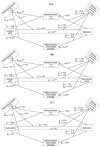Maternal Mental Health Symptom Profiles and Infant Sleep: A Cross-Sectional Survey
- PMID: 35885530
- PMCID: PMC9319039
- DOI: 10.3390/diagnostics12071625
Maternal Mental Health Symptom Profiles and Infant Sleep: A Cross-Sectional Survey
Abstract
The distinct influence of different, but comorbid, maternal mental health (MMH) difficulties (postpartum depression, anxiety, childbirth-related posttraumatic stress disorder) on infant sleep is unknown, although associations between MMH and infant sleep were reported. This cross-sectional survey aimed: (1) to examine associations between MMH symptoms and infant sleep; (2) to extract data-driven maternal MMH symptom profiles from MMH symptoms; and (3) to investigate the distinct influence of these MMH symptom profiles on infant sleep when including mediators and moderators. Mothers of 3-12-month-old infants (n = 410) completed standardized questionnaires on infant sleep, maternal perception of infant negative emotionality, and MMH symptoms. Data was analyzed using: (1) simple linear regressions; (2) factor analysis; and (3) structural equation modelling. MMH symptoms were all negatively associated with nocturnal sleep duration and only postpartum depression and anxiety symptoms were associated with night waking. Three MMH symptom profiles were extracted: depressive, anxious, and birth trauma profiles. Maternal perception of infant negative emotionality mediated the associations between the depressive or anxious profiles and infant sleep but only for particular infant ages or maternal education levels. The birth trauma profile was not associated with infant sleep. The relationships between MMH and infant sleep may involve distinct mechanisms contingent on maternal symptomatology.
Keywords: City BiTS; EPDS; HADS; PTSD; anxiety; birth trauma; depression; infant sleep; mothers; temperament.
Conflict of interest statement
The authors declare no conflict of interest.
Figures


References
-
- Gustafsson E. La Science Au-Dessus du Berceau: La Recherche Au Service Des 0 à 6 Ans. Max Milo; Paris, France: 2020. Les nuits et les pleurs des bébés.
Grants and funding
LinkOut - more resources
Full Text Sources
Research Materials
Miscellaneous

